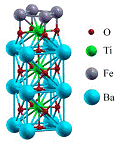Department of Physics and Astronomy: Publications and Other Research
Date of this Version
4-23-2019
Citation
Physical Review Materials 3, 044409 (2019).
DOI: 10.1103/PhysRevMaterials.3.044409
Abstract
The anomalous Hall effect (AHE) is a well-known fundamental property of ferromagnetic metals, commonly associated with the presence of a net magnetization. Recently, an AHE has been discovered in noncollinear antiferromagnetic (AFM) metals. Driven by nonvanishing Berry curvature of AFM materials with certain magnetic space-group symmetry, anomalous Hall conductivity (AHC) is very sensitive to the specific type of magnetic ordering. Here, we investigate the appearance of AHC in antiperovskite materials family ANMn3 (A = Ga, Sn, Ni), where different types of noncollinear magnetic ordering can emerge. Using symmetry analyses and first-principles density-functional theory calculations, we show that with almost identical band structure the nearly degenerate noncollinear AFM Γ5g and Γ4g phases of GaNMn3 have zero and finite AHC, respectively. In a noncollinear ferrimagnetic M-1 phase, GaNMn3 exhibits a large AHC due to the presence of a sizable net magnetic moment. In the noncollinear antiperovskite magnets, transitions between different magnetic phases, exhibiting different AHC states, can be produced by doping, strain, or spin transfer torque, which makes these materials promising for novel spintronic applications.


Comments
Copyright 2019 American Physical Society. Used by permission.